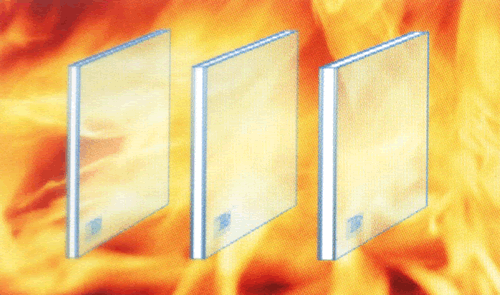Pirotherm Panels

After long term tests in collaboration with the largest manufacturers of chemicals, Kamaridis GlobalWire Group has achieved an improved new series of polyurethane panels on the issue of fire by managing to reduce emissions of carbon dioxide.
The improved fire performance (reduced smoke emissions and rate of spread of flame) combined with the best thermal insulation capacity, higher mechanical strength and foam density, make this product the most reliable component of all polyurethane panels today.
For the production of polyurethane panels the chemical used are according to DIN 4102 and classed PIR. The foam structure PIR (polyisocyanurate) from PIRotherm series are classified in the highest category S2 (BS2D0) due to the minimum smoke emission during combustion. Subclass S2 defines a panel with very low smoke production. And finally, the sub-classification d0 entails that there are no flaming droplets.
|
Flammability Classes of Building Materials Excluding Floorings (according to TS EN 13501) |
|
|
Flammability Class |
Definition |
|
A1 s |
Materials in Class A1 do not contribute to the burning at any stage of burning including the fully developed fire. Therefore these materials by themselves are thought to meet all specifications designated for all lower classes. |
|
A2 |
Metts criteria defined for class B according to TS EN 13828. Additionally, these materials must not significantly contribute to fire load and fire development under fully developed fire conditions. |
|
B |
Besides meeting criteria designated for Class C, they also meet stricter requirements. |
|
C |
Besides meeting criteria designated for Class D, they also meet stricter requirements. Moreover, lateral fire spread must have a limited rate against thermal attack by single flame item. |
|
D |
Materials meeting Class A criteria with long-term resistance to a small flame attack without significant flame spread. Additionally, it must be resistant to thermal attack conditions by a single burning item kept adequately and emitting limited heat. |
|
E |
Materials without significant flame spread and with short term resistance to a small flame attack. |
|
F |
Materials with undetermined fire performance, and not classified under either A1, A2, B, C, D or E class |
|
Additional Classifications for Smoke Formation |
|
|
s3 |
No limitation in terms of smoke production |
|
s2 |
With limited smoke production increase rate along with limited total smoke production |
|
s1 |
Ensuring criteria stricter than s2 |
|
Additional Classifications for Burning Droplets / Particles |
|
|
d2 |
No limitation |
|
d1 |
No burning droplet/particle should occur longer than the designated period |
|
d0 |
No burning droplet/particle should occur |
PIRotherm panels are produced from PIR foams, based on new polyols, without halogenated flame retardant additives, HCFC-free and average index value formulations, leading to a new generation of panels called PIRotherm. They are dimensionally stable and have optimal adhesion properties.
Our PIR molecule, unlike the linear chains of other polyurethanes, has a network structure that provides stability and reaction to fire properties, as has been proved by its success in passing the SBI (Single Burning Item) test, with a BS2d0 classification.
PIR Panel is a Factory Mutual approved product and is accepted worldwide as the best fire rated solution for insulated panel construction. The PIR core is manufactured by mixing two chemical streams with appropriate catalysts and a blowing agent. Pentane, which has zero ozone depleting potential and Polyisocyanurate (PIR) a rigid polyurethane foam that can be used in the manufacture of, either flat panel or profiled panel solutions, to meet a variety of applications where a light weight insulated fire resistant panel solution is required.
Physical & Mechanical properties
|
Core Density |
44±2 |
kg/m3 |
ISO 854 |
|
Compression strength at 10% |
|
|
|
|
Dimensional stability |
|
|
|
|
Thermal Conductivity λ |
0,020 |
kcal / mh °C |
ASTM C 518 |
|
Tensile Stress |
>0,10 |
N/mm2 |
DIN 53292-82 |
|
Tensile Strength |
<5,0 |
N/mm2 |
DIN 53292-82 |
|
Deflection |
>0,12 |
N/mm2 |
DIN 53293-82 |
|
Stiffness coefficient |
~2,55 |
N/mm2 |
DIN 53293-82 |
|
Compression stress |
>0,08 |
N/mm2 |
DIN 53291-82 |
|
Compression strength |
>3,52 |
N/mm2 |
DIN 53291-82 |
|
Panel Thickness (mm) |
Thermal Transmittance U-Value (W/m2K) |
| 50 | 0,36 |
| 60 | 0,31 |
| 80 | 0,26 |
| 100 | 0,21 |
| 120 | 0,18 |
| 140 | 0,13 |
| 160 | 0,12 |
| 180 | 0,11 |
| 200 | 0,10 |
The U-values in the above table are measured at 25oC with thermal conductivity of k=0,020 kw/mk
Materials
Steel Technical Characteristics (EN 10327 / EN 10142 / EN 10143)
|
Quality |
DX51D or S-220 or S-250 or S-280 or S-320 |
|
Width |
1.250mm / 1.100 / 1.070mm |
|
Tensile Strength |
EN 10142 |
Paint Technical Characteristics (SP)
|
Topcoat + Primer |
25 mic. |
|
Backcoat |
5-7 mic. |
